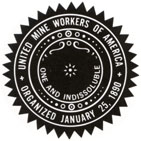United Mine Workers
|
|
The United Mine Workers (UMW or UMWA) is a United States labor union that represents workers in mining. One of the groups in the forefront of the fight for collective bargaining in the early 20th century, the UMW was founded in Columbus, Ohio, on January 22, 1890, by the merger of two earlier groups, the Knights of Labor Trade Assembly No. 135 and the National Progressive Union of Miners and Mine Laborers. It was modeled after the American Federation of Labor (AFL).
After passage of the National Recovery Act in 1933, organizers spread out throughout the United States to organize all coal miners.
| Contents |
Achievements
- An eight-hour work day in 1898, collective bargaining rights in 1933, and safety protections in 1969.
- In 1969, the UMWA convinced the United States Congress to enact the landmark Federal Coal Mine Health and Safety Act which provided compensation for miners suffering from Black Lung Disease.
Famous UMWA leaders include John Mitchell, John L. Lewis, and Mother Jones.
Violent Clashes
Its history is filled with violent clashes with industrial leaders, including:
- Lattimer Massacre - September 10, 1897. 19 miners were killed by police in Lattimer, Pennsylvania, during a march in support of unions.
- Ludlow Massacre - April 20, 1914. 20 people, including women and children, killed when police and hired guns broke up a tent colony formed by families of miners who had been evicted from company-owned housing.
- Matewan, West Virginia - May 19, 1920. 12 men were killed in a gunfight between town residents and the Baldwin Felts Detective Agency, hired by mine owners. This is depicted in the John Sayles film Matewan.
Further History
- On October 21, 1902, a five month strike by the United Mine Workers ended.
The Harlan County War
- In the summer of 1973, workers at the Duke Power-owned Eastover Coal Company's Brookside Mine and Prep Plant in Harlan County, Kentucky voted to join the union. Eastover management refused to sign the contract and the union went on strike. Duke Power brought in replacement non-union workers (scabs). The replacement workers would not respect the picket lines and violence ensued. Hogg, the local judge was a coal operator himself and consistently ruled for Eastover. He was accused of being paid off by the company. During the final months of the strike the mine workers' wives and children began manning the picket lines. They were arrested, hit by baseball bats, shot at and struck by cars. Three months after returning to work, UMWA's contract expired. On November 12, 1974, 120,000 miners nationwide walked off the job. This strike was bloodless and a tentative contract was achieved three weeks later. This opened the mines and reactivated the railroad haulers in time for Christmas. These events are depicted in the films Harlan County War and Harlan County, USA.
The union's more recent history has sometimes been marked by internal strife and corruption, including the 1969 murder of Joseph Yablonski, a reform candidate who lost a race for union president against incumbent W.A. (Tony) Boyle. Boyle was later convicted of ordering the murder.
Automation and a general decline in American unions have cut heavily into the UMW's membership since World War II. In 1998 the UMW had about 240,000 members, half the number it had in 1946. It represents about 42 percent of all employed miners. The UMW is most powerful in West Virginia, as well as in Montana and other western states.
External link
- United Mine Workers of America (http://www.umwa.org/) official site

